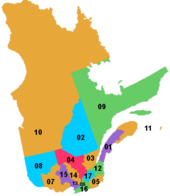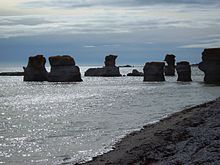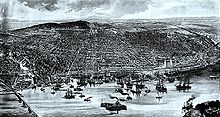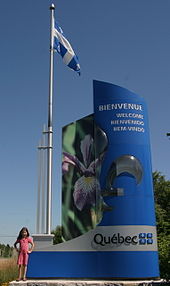Quebec
![]()
This article describes the Canadian province. For the city, see Quebec (city). For other meanings, see Quebec (disambiguation).
Québec (German spelling also spelled Quebec without accent; French Québec [keˈbɛk], English Quebec [kwɨˈbɛk] or [kəˈbɛk], originally Algonkin Kebec for "where the river narrows") is the largest province in Canada by area (the larger Nunavut is not a province but a territory) and the one with the largest Francophone population. With its language, culture and institutions, it is a distinct national community within Canada.
Québec is located in eastern Canada between Hudson Bay and the border with the United States along the Saint Lawrence River (Fleuve Saint-Laurent in French).
The population comprises 8.52 million inhabitants, the Quebecers (French Québécois). Québec is the only region of mainland North America with a French-speaking majority. Although both English and French are official languages in Canada, the exclusive official language of the province of Québec is French. The capital of the province is also called Québec; the largest city is Montreal. In 2006, Quebecers were officially recognized as a "nation in a united Canada". A nation can invoke international law, often referred to as "international law", while an ethnic group can only invoke minority protections. Also referred to as nations (First Nations/Premières Nations) in official usage are some of Canada's aboriginal peoples.
Québec politics is marked by a permanent debate about the role of the Francophonie in majority Anglophone Canada, from which many efforts to increase Québec's sovereignty have emerged, ranging from expanded powers to association with Canada to outright secession. In 1980 and 1995, the province held referendums on independence, each of which narrowly failed.
Québec's indigenous population includes 39 recognized First Nations (Indians) linguistically belonging to the Iroquois (such as Mohawk, Wyandot) and Algonkin (Cree, Mi'kmaq) groups, as well as the Inuit with the Inuktitut language.
Geography
Québec is located in eastern Canada, bordering the province of Ontario and Hudson Bay to the west, the provinces of Newfoundland and Labrador and New Brunswick to the east, the United States (states of Maine, New Hampshire, Vermont, New York) to the south, and Nunavut to the north. The province is very extensive - about three times the size of France - and very sparsely populated. The highest point is Mont D'Iberville (1652 m or 5420 feet), known to English-speaking Canadians as Mount Caubvick, situated in the Torngat Mountains on the border between Quebec and Newfoundland and Labrador. On the Quebec side, however, is only the secondary peak, about 30 cm lower, at 5419 feet, while the 5420-foot summit proper of Mount Caubvick is about 10 metres northeast of the Quebec provincial boundary, and thus entirely in Labrador territory.
The Saint Lawrence River, which shapes the province to a great extent, is one of the most powerful rivers in the world as the outflow of the Great Lakes. In the 17th and 18th centuries, it provided French explorers and settlers with easy access from the Atlantic Ocean to the interior. Since 1959, it has formed part of the Saint Lawrence Seaway. Northeast of the provincial capital of Quebec, the river widens into the world's largest estuary and eventually empties into the Gulf of St. Lawrence. The largest island in this gulf and the largest island in the province is Anticosti, north of the Gaspésie Peninsula.
By far the most densely populated region is the Saint Lawrence lowlands, which extend from the southwest along the stream northeastward through Montreal and Trois-Rivières to the metropolitan area of Quebec City. The landscape is flat and low-lying, with the exception of some rocky hills of igneous rock near Montréal called the Montérégie Hills. The most recent sedimentary deposits were formed about 14,000 years ago when the shallow Champlain Sea was filled in at the end of the Würm Ice Age. The combination of fertile soil and the province's mildest climate make the valley the most agricultural region.
More than four-fifths of Québec's land area is located on the Labrador Peninsula, part of the Canadian Shield. The landscape is predominantly inhospitable and very sparsely populated, but has rich deposits of mineral resources and large hydroelectric resources. The northernmost part, the Nunavik region on the Ungava Peninsula, consists of Arctic tundra. Further south is a strip of boreal coniferous forest several hundred kilometres wide. The border of the shield is formed by the Laurentian Mountains, one of the oldest mountain ranges in the world. On the southeastern border of the province extend the Appalachian Mountains, which are covered by mixed forests.
Climate
Québec has three main climatic regions. The south and west, with the largest metropolitan areas, are characterized by a humid continental climate (Effective Climate Classification Dfb) with warm, humid summers and long, cold winters. The most significant climatic influences come from western and northern Canada and the southern and central United States. As a result of the influence of storm systems from the heart of North America and the Atlantic Ocean, abundant precipitation falls throughout the year. Most areas receive more than 1000 mm of precipitation per year, including 300 mm of snow. In summer, extreme weather situations such as tornadoes and thunderstorms are far less common than in southern Ontario, for example, but do occur here occasionally.
Much of the central province has a subpolar climate (class Dfc). Winters here are long and among the coldest in Canada, while summers are warm but short due to high latitude and the influence of Arctic air masses. Precipitation is somewhat lower than in the south, except at the higher elevations.
The northern regions of the province have a polar climate (class ET) with very cold winters and short, much cooler summers. The main climatic influences are Arctic Ocean currents (such as the Labrador Current) and continental air masses from the Arctic.
Management structure
See also: Administrative division of Québec and List of municipalities in Québec
Québec is divided into 17 administrative regions (régions administratives). These in turn are made up of regional county municipalities (municipalités régionales de comté, MRC), which assume certain supra-regional administrative tasks. These include the preparation of a land use plan, water supply and waste management. 14 municipalities carry out the tasks of the MRC themselves. In the metropolitan areas of Québec and Montréal, there is an additional level, the metropolitan association (communauté métropolitaine, CM). Since the 1980s, this structure has replaced the former subdivision into counties (comtés).
Finally, the lowest level of local self-government is formed by the municipalities. The municipal forms in Québec are the city (ville), the municipality (municipalité), the village (village), the parish (paroisse), the canton (canton) and the Nordic, Cree and Naskapi villages (villages nordique, cri et naskapi).

Map Québec

Satellite photo of three hills of the Montérégie hill range

Administrative regions

.jpg)
The Laurentian Mountains

Monoliths on Quarry Island off Havre-St-Pierre
History
→ Main article: History of Québec and History of the First Nations
See also: List of National Historic Sites of Canada in Québec
Prehistory and European exploration
Québec was originally the settlement area of indigenous peoples such as Inuit, Mohawks, Cree, Algonkin, Innu, Atikamekw, Mi'kmaq, Wyandot, Abenaki, Maliseet and Naskapi. While most peoples in the Canadian Shield and Appalachian Mountains led nomadic lives as hunters, gatherers, and fishermen, the Saint Lawrence Iroquois were sedentary and practiced agriculture.
Basque whalers and fishermen came regularly to the eastern Canadian coast from about 1525 onwards and advanced as far as the estuary of the Saint Lawrence River. The first European explorer to reach the interior of Québec was the Frenchman Jacques Cartier. He reached Gaspé in 1534 and navigated the stream the following year. Pierre Chauvin founded a first trading post in Tadoussac at the mouth of the Saguenay River in 1600.
New France
In 1608, Samuel de Champlain founded Québec City, which was named the capital of the colony of New France. Trade relations and eventually military alliances were formed with the Algonkin and the Wyandot. Furs were exported to France, and in return the Indians received metal goods, firearms, and alcohol. From Quebec City, rangers (coureurs des bois) and Catholic missionaries explored the interior of the North American continent. Other settlements were founded along the St. Lawrence River (Fleuve St. Laurent) as late as the 17th century (Montréal 1648).
The name "Québec", which means "where the river narrows" in the Algonquin language, originally referred to the area around Québec City where the Saint Lawrence River squeezes through a narrows bordered by steep cliffs. Early variations of the spelling of the name include Québecq (1601) and Kébec (1609).
In 1627, King Louis XIII granted the Compagnie de la Nouvelle-France a monopoly on the fur trade, established a semi-feudal land grant system (régime seigneurial), and forbade the settlement of non-Catholics. Sulpicians and Jesuits established missions to convert the Algonkin and Wyandot. Because colonization progressed very slowly under the direction of the Company, New France became a royal colony in 1663 under Louis XIV. During King William's War, Québec was attacked from New England for the first time. As a result, the city's fortifications were strengthened. Over the next hundred years, the number of French settlers, who called themselves Canadiens, increased twentyfold to about 60,000. Because of the Crown's refusal to allow the Huguenots to settle, the population fell far short of that of the Thirteen Colonies.
In 1753, France began building forts in the Ohio Territory to push back Britain's influence. The following year, a skirmish at Fort Duquesne near present-day Pittsburgh began the French and Indian War, which formed a sub-conflict of the Seven Years' War. The Wyandot fought on the side of the French, while the British allied with the Iroquois. In 1759, the French were defeated at the Battle of the Plains of Abraham. By the Peace of Paris in 1763, New France fell to Great Britain. The colony was renamed the Province of Quebec by Royal Proclamation that same year.
British rule
Since the assimilation of the predominantly French-speaking population had failed, the British Parliament passed the Quebec Act in 1774. This act recognized the French legal system, religious freedom, and the French language and culture. This was to prevent Quebecers from joining the rebellious Thirteen Colonies.
However, the Act also angered the Thirteen Colonies by shifting Quebec's borders into the Ohio Territory and Illinois Country. It was one of those Intolerable Acts that led to the outbreak of the AmericanWar of Independence. In 1775, the invasion of Québec was repulsed. Tens of thousands of Loyalists fled to what is now Canada. With the Peace of Paris, the territories south of the Great Lakes were ceded to the United States.
To accommodate the Loyalists who had fled, the British Parliament passed the Constitution Act of 1791, which divided the province of Quebec into French-speaking Lower Canada and English-speaking Upper Canada and granted both colonies an elected parliament. Tensions between the United States and Great Britain erupted in the British-American War, which lasted from 1812 to 1814 but ultimately ended inconclusively.
As in neighbouring Upper Canada, Louis-Joseph Papineau and Robert Nelson formed a rebel movement in 1837 whose aim was to end British colonial rule (→ Rebellions of 1837). The British army was initially completely unprepared, but managed to put down the rebellion. Based on a report by Lord Lambton, who had investigated the causes of the rebellion, Lower and Upper Canada were united in 1840 to form the province of Canada. In 1848, the province was granted the right of self-government and the first democratically elected government.
Canadian province
In the 1860s, delegates from various colonies began negotiating unification in British North America. Eventually, on July 1, 1867, the Dominion of Canada came into being with the enactment of the British North America Act, and the former Province of Canada was divided into the provinces of Ontario (formerly Upper Canada) and Québec (formerly Lower Canada). Canada as a whole was majority English-speaking, but in Québec the Francophones formed the majority.
In 1870, the Canadian federal government had acquired Rupert's Land from the Hudson's Bay Company and created the Northwest Territories. Over the next few decades, the federal government ceded large portions of these territories to existing provinces or created new provinces. In two stages, Quebec was able to expand its area by more than three times (see also Territorial Development of Canada). On June 13, 1898, the first extension was to the James Bay coast. A second act, on May 15, 1912, added the Ungava District in the north of the Labrador Peninsula to the province. On March 11, 1927, the Judicial Committee of the British Privy Council ruled in favour of the then independent Dominion of Newfoundland in a boundary dispute, whereupon Quebec had to cede a strip of territory.
While industrialization was initially limited to the city of Montreal, it began to spread to the rest of the province in the late 19th century. This was accompanied by a rapid urbanization of the province, combined with a high birth rate. Especially in the rural part, the Roman Catholic Church exerted a great influence on society and dominated education, while in the cities a small English-speaking elite controlled economic activity. In the first decades of the 20th century, industrialization also began in the rural regions, based on the further processing of natural resources.
Two ideological currents were dominant: on the one side were the liberals, who called for the modernization of economic and social structures and saw economic growth and the expansion of education as the only way to lead the province into the future. Opposing them were conservative nationalists who pursued an isolationist course based on the values of Catholicism and rural traditionalism.
Until the late 1950s, the Union nationale, with Maurice Duplessis at its head, consistently opposed reform. However, when Jean Lesage's Parti libéral du Québec came to power in 1960, it set in motion a course of reform that modernized Québec society and government from the ground up and became known as the Quiet Revolution (révolution tranquille). The government pushed back the influence of the Roman Catholic Church under the slogan Maître chez nous ("master in our own house"). It also nationalized Hydro-Québec, an energy company whose development of local energy reserves laid the "foundation for sweeping industrialization."
Separatism
However, the Silent Revolution also gave rise to a new kind of nationalism that was no longer based on traditional values. Several separatist movements emerged, some of them militant. The Front de libération du Québec (FLQ) carried out more than 200 bombings and bank robberies between 1963 and 1970, with the aim of turning the province into a Marxist state. The wave of terror culminated in the October Crisis and the federal government's brief imposition of a state of emergency. As a result, the FLQ was crushed.
In contrast, René Lévesque's Parti Québécois attempted to lead Québec to independence by peaceful means. It formed the provincial government for the first time in 1976. Two years earlier, French had already been declared the sole official language, but with the Charter of the French Language issued in 1977, the influence of English was finally pushed back, even in everyday life. In the 1980 Québec referendum, 59.6% of the electorate voted against secession from the Canadian confederation on May 20, 1980, not least for economic reasons. On the other hand, the province has still not ratified the 1982 constitution initiated by Pierre Trudeau.
Efforts by the federal government to recognize Québec as a "distinct society" through the Meech Lake Accord and the Charlottetown Accord failed in 1989 and 1992, respectively. The Parti Québécois returned to power in 1994 and scheduled a second independence referendum. The 1995 Québec referendum failed by an extremely narrow margin of 50.58% No to 49.42% Yes. It later became public that the federalists had spent nine times as much money on the referendum campaign as the separatists, including government money. The federal government had also influenced the election by increasing the number of naturalizations before the vote. In 1998, the Supreme Court of Canada, in its decision Renvoi relatif à la sécession du Québec, determined that a province could not unilaterally declare itself independent.
On the initiative of Conservative Prime Minister Stephen Harper, the Canadian House of Commons recognized Quebecers as a "nation within a united Canada" on November 27, 2006. Harper said that this does not call Canada's unity into question.

Map of New France by Samuel de Champlain (1612)

The Battle of Queenston Heights, October 13, 1812.
_b_469.jpg)
Québec (1854)

Montréal in 1889

Flag and border sign of the province of Québec
Questions and Answers
Q: What is the largest province in Canada?
A: Quebec is the largest of Canada's ten provinces by size.
Q: What language do most people in Quebec speak?
A: Most people in Quebec speak French (Canadian French) and it is the only official language.
Q: How has Quebec's culture been influenced?
A: Quebec's culture was influenced by English-speaking Canada and also the United States.
Q: Where are the government offices located in Quebec?
A: The government of Quebec has its offices in the capital, Quebec City.
Q: What city has the most people in the province?
A: The city with the most people in the province is Montreal, which is also the second-largest city in Canada.
Q: What natural resources does Quebec have that create jobs?
A: Quebec has many natural resources that are used to create jobs.
Q: What industries does Québec specialize in creating products for?
A: Québec specializes in creating products for information and communication technologies, aerospace, biotechnology, and health industries.
Search within the encyclopedia